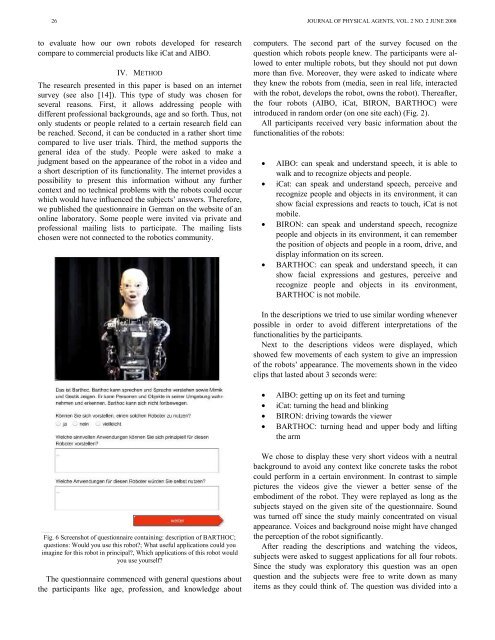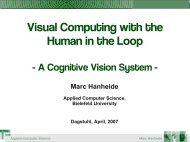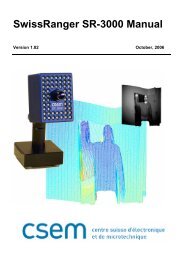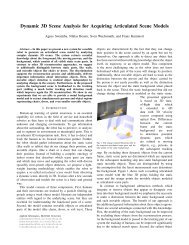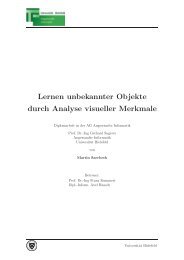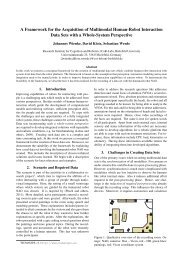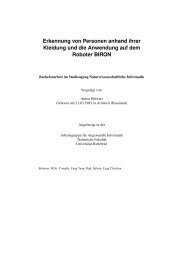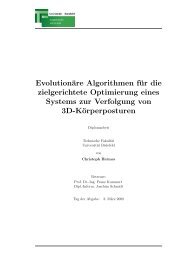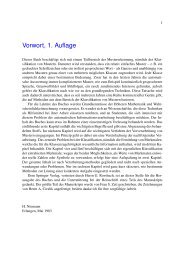Domestic Applications for Social Robots - Journal of Physical Agents
Domestic Applications for Social Robots - Journal of Physical Agents
Domestic Applications for Social Robots - Journal of Physical Agents
Create successful ePaper yourself
Turn your PDF publications into a flip-book with our unique Google optimized e-Paper software.
26 JOURNAL OF PHYSICAL AGENTS, VOL. 2 NO. 2 JUNE 2008<br />
to evaluate how our own robots developed <strong>for</strong> research<br />
compare to commercial products like iCat and AIBO.<br />
IV. METHOD<br />
The research presented in this paper is based on an internet<br />
survey (see also [14]). This type <strong>of</strong> study was chosen <strong>for</strong><br />
several reasons. First, it allows addressing people with<br />
different pr<strong>of</strong>essional backgrounds, age and so <strong>for</strong>th. Thus, not<br />
only students or people related to a certain research field can<br />
be reached. Second, it can be conducted in a rather short time<br />
compared to live user trials. Third, the method supports the<br />
general idea <strong>of</strong> the study. People were asked to make a<br />
judgment based on the appearance <strong>of</strong> the robot in a video and<br />
a short description <strong>of</strong> its functionality. The internet provides a<br />
possibility to present this in<strong>for</strong>mation without any further<br />
context and no technical problems with the robots could occur<br />
which would have influenced the subjects’ answers. There<strong>for</strong>e,<br />
we published the questionnaire in German on the website <strong>of</strong> an<br />
online laboratory. Some people were invited via private and<br />
pr<strong>of</strong>essional mailing lists to participate. The mailing lists<br />
chosen were not connected to the robotics community.<br />
Fig. 6 Screenshot <strong>of</strong> questionnaire containing: description <strong>of</strong> BARTHOC;<br />
questions: Would you use this robot?; What useful applications could you<br />
imagine <strong>for</strong> this robot in principal?, Which applications <strong>of</strong> this robot would<br />
you use yourself?<br />
The questionnaire commenced with general questions about<br />
the participants like age, pr<strong>of</strong>ession, and knowledge about<br />
computers. The second part <strong>of</strong> the survey focused on the<br />
question which robots people knew. The participants were allowed<br />
to enter multiple robots, but they should not put down<br />
more than five. Moreover, they were asked to indicate where<br />
they knew the robots from (media, seen in real life, interacted<br />
with the robot, develops the robot, owns the robot). Thereafter,<br />
the four robots (AIBO, iCat, BIRON, BARTHOC) were<br />
introduced in random order (on one site each) (Fig. 2).<br />
All participants received very basic in<strong>for</strong>mation about the<br />
functionalities <strong>of</strong> the robots:<br />
• AIBO: can speak and understand speech, it is able to<br />
walk and to recognize objects and people.<br />
• iCat: can speak and understand speech, perceive and<br />
recognize people and objects in its environment, it can<br />
show facial expressions and reacts to touch, iCat is not<br />
mobile.<br />
• BIRON: can speak and understand speech, recognize<br />
people and objects in its environment, it can remember<br />
the position <strong>of</strong> objects and people in a room, drive, and<br />
display in<strong>for</strong>mation on its screen.<br />
• BARTHOC: can speak and understand speech, it can<br />
show facial expressions and gestures, perceive and<br />
recognize people and objects in its environment,<br />
BARTHOC is not mobile.<br />
In the descriptions we tried to use similar wording whenever<br />
possible in order to avoid different interpretations <strong>of</strong> the<br />
functionalities by the participants.<br />
Next to the descriptions videos were displayed, which<br />
showed few movements <strong>of</strong> each system to give an impression<br />
<strong>of</strong> the robots’ appearance. The movements shown in the video<br />
clips that lasted about 3 seconds were:<br />
• AIBO: getting up on its feet and turning<br />
• iCat: turning the head and blinking<br />
• BIRON: driving towards the viewer<br />
• BARTHOC: turning head and upper body and lifting<br />
the arm<br />
We chose to display these very short videos with a neutral<br />
background to avoid any context like concrete tasks the robot<br />
could per<strong>for</strong>m in a certain environment. In contrast to simple<br />
pictures the videos give the viewer a better sense <strong>of</strong> the<br />
embodiment <strong>of</strong> the robot. They were replayed as long as the<br />
subjects stayed on the given site <strong>of</strong> the questionnaire. Sound<br />
was turned <strong>of</strong>f since the study mainly concentrated on visual<br />
appearance. Voices and background noise might have changed<br />
the perception <strong>of</strong> the robot significantly.<br />
After reading the descriptions and watching the videos,<br />
subjects were asked to suggest applications <strong>for</strong> all four robots.<br />
Since the study was exploratory this question was an open<br />
question and the subjects were free to write down as many<br />
items as they could think <strong>of</strong>. The question was divided into a


